History
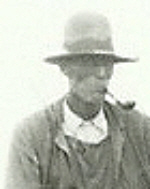 My great grandfather, Cornelius Byer was a friend of the Indians at a time in history, when that was rather uncommon. During his lifetime, the White Man was well known for backing out on treaties as the need or desire for more land warranted, resulting in the pushing back of the Indians further and further off of the land they had been promised. This of course eventually resulted in the placement of the Indians onto reservations, many of which still exist to this day. It also cause much contention between the Indians and the White Man, and of course, the Indian Wars. At that time and even beyond, many Indians did not trust the White Man, even after peace came about, however my great grandfather was a man they not only trusted, but indeed, loved and respected. Over the years, the family would see many times when the Indians would show up at the house, with their whole families in tow. The women and children always waited outside while the men went in to visit with Grandpa about whatever it was they had come for. For the children, I suppose all this seemed normal, but when we look at it in light of history, it seems strange to think of the Indians having such trust and respect for any White Man, and therefore strange to think that they came to the house, and that they were welcomed into it. Nevertheless, this is what happened, and Great Grandpa Byer went to their villages as well.
My great grandfather, Cornelius Byer was a friend of the Indians at a time in history, when that was rather uncommon. During his lifetime, the White Man was well known for backing out on treaties as the need or desire for more land warranted, resulting in the pushing back of the Indians further and further off of the land they had been promised. This of course eventually resulted in the placement of the Indians onto reservations, many of which still exist to this day. It also cause much contention between the Indians and the White Man, and of course, the Indian Wars. At that time and even beyond, many Indians did not trust the White Man, even after peace came about, however my great grandfather was a man they not only trusted, but indeed, loved and respected. Over the years, the family would see many times when the Indians would show up at the house, with their whole families in tow. The women and children always waited outside while the men went in to visit with Grandpa about whatever it was they had come for. For the children, I suppose all this seemed normal, but when we look at it in light of history, it seems strange to think of the Indians having such trust and respect for any White Man, and therefore strange to think that they came to the house, and that they were welcomed into it. Nevertheless, this is what happened, and Great Grandpa Byer went to their villages as well.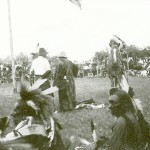
On one such visit to the Indian village of Chief Red Cloud, my grandfather, George Byer was allowed to go along. He recalled that when they entered the tent, Chief Red Cloud was sitting by a fire wrapped in his robe or blanket. Apparently it was customary in this case for him to have little or nothing on underneath that, so I almost have to wonder if it was a sweat lodge or something. Either way, that is what my grandfather recalled as a young boy of about ten years. His dad had gone to visit Red Cloud about something, and in during the visit, the peace pipe was passed around. When it was handed to my grandfather, he was allowed to take it and that resulted in his smoking the peace pipe for the first time as a very young boy, who was apparently considered man enough to do so by the Indians. I doubt if many of us can say, in this day and age, that they know someone who smoked a peace pipe before, but that is the truth.
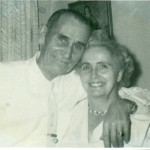
My great grandpa was so greatly respected that not only was he asked to smoke the peace pipe with them, but when he was dying, a rather amazing thing happened. Because he had been their friend, the Indians came to pay their respects. As they had before, they brought their families, but this time the families did not stay outside. The braves came in to shake Great Grandpa’s hand, as did their wives, and their children. Every single one of them shook his hand…from the oldest to the youngest. It was such a moving show of respect for him, and one that was almost never afforded to a White Man. But then, Great Grandpa Cornelius Byer was their friend, and that made him more than just any other White Man. He was like a brother to them.
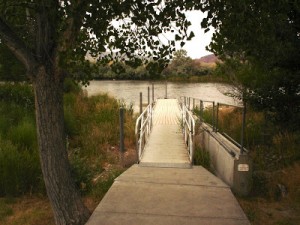 There is a unique place near Thermopolis, Wyoming, that some people in Wyoming know about, or maybe they don’t, but people outside of Wyoming most likely don’t know about it. This place is called Wedding of the Waters. The name might seem to imply that two rivers meet and become one, but that is not the case. In this place located four miles south of Thermopolis, Wyoming, something strange happens. It is the only place I know of where one river flows to a certain point, then changes its name and becomes a completely different river. It isn’t that the river was given a nickname, but rather is completely changes it’s name, like a wife does after her marriage.
There is a unique place near Thermopolis, Wyoming, that some people in Wyoming know about, or maybe they don’t, but people outside of Wyoming most likely don’t know about it. This place is called Wedding of the Waters. The name might seem to imply that two rivers meet and become one, but that is not the case. In this place located four miles south of Thermopolis, Wyoming, something strange happens. It is the only place I know of where one river flows to a certain point, then changes its name and becomes a completely different river. It isn’t that the river was given a nickname, but rather is completely changes it’s name, like a wife does after her marriage.
The way this happened is rather strange. The river begins ninety miles northeast of the actual wedding site. It runs southeast, then winds around to the north and flows through two mountain ranges before joining the Yellowstone River at Bighorn, Montana, 180 miles northeast of the wedding site. From there it eventually reaches the Gulf of Mexico by way of the Missouri and Mississippi Rivers.
When early settlers arrived at the river in what is now the state of Montana, they named it the Bighorn River for the big horn sheep they found near it. Other explorers who found the river south of the wedding site named it the Wind River. Eventually, the people realized that in reality, there was only one river…with two names that had been well established. To avoid confusion, it was decided that a wedding was necessary. That wedding took place, and in fact continues to take place in this quaint little spot known as Wedding of the Waters. The river south of this point is the Wind River, and the river north of this point is the Big Horn River.
The native Indians, mountain men, and early settlers felt like this place was special. I suppose the history of such a compromise made it special. The animals find the place special too, because of the unique vegetation found there. That is mainly due to the warmer water being released from the Boysen Reservoir. Warm thermal spring water adds to the warmth of the water, and it becomes a unique habitat for mule deer, whistling marmots, and mink. The bald eagles are attracted to the rainbow, cutthroat, and brown trout, as well as burbot 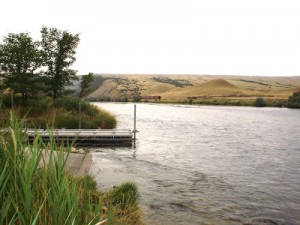 and mountain whitefish. That makes it great for fishermen too. The fish in the river grow quickly because of the many aquatic insects found in the bottom vegetation. And this area even sports the nation’s first handicap-accessible riverine boat ramp that provides drift boat access to the Big Horn River.
and mountain whitefish. That makes it great for fishermen too. The fish in the river grow quickly because of the many aquatic insects found in the bottom vegetation. And this area even sports the nation’s first handicap-accessible riverine boat ramp that provides drift boat access to the Big Horn River.
I think it’s kind of sad that this quaint little spot is so often passed by as if it isn’t even there. I suppose it doesn’t have the advantage of the spectacular canyon scenes just to the south, or the draw of the hot water mineral springs just to the north. Nevertheless, the Wedding of the Waters really is a very special place in its own right, and one that is interesting to go see.
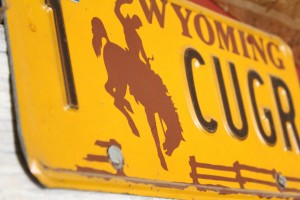
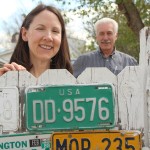 I don’t know for sure how it all started, but over the years, my father-in-law, Walt Schulenberg collected a number of old license plates that were both unique and average. My guess is that he found one that he really liked, and he saved it, putting it up on the wall of the garage. Before long, the number of plates grew, because there was always another unique license plate to add to the collection. After a while the license plate collection grew to include plates from the different states he had been in, and his son, Ron Schulenberg even brought him some from the countries he was in during Desert Storm…which were quite different from all the others.
I don’t know for sure how it all started, but over the years, my father-in-law, Walt Schulenberg collected a number of old license plates that were both unique and average. My guess is that he found one that he really liked, and he saved it, putting it up on the wall of the garage. Before long, the number of plates grew, because there was always another unique license plate to add to the collection. After a while the license plate collection grew to include plates from the different states he had been in, and his son, Ron Schulenberg even brought him some from the countries he was in during Desert Storm…which were quite different from all the others.
These license plates started out gracing the walls of the garage, which is a fitting place for such a collection, but as time went on, there were enough of then to warrant adding the barn shop my father-in-law had, and finally the back fence to his display areas. In reality, while I found these interesting to look at from time to time, my father-in-law’s license plate was not something that occupied any kind of a special place in my mind. I suppose that if I was a guy, I might have felt differently about it. It is a guy type of collection, after all.
After someone passes away, and you find yourself sorting through all their things, you begin to really get a feel for what was important to them. Not just the major things they had placed a high degree of importance on, but the lesser things too. The things they just liked, because they thought those things were cool. That was how it was for me, when we started going through my father-in-law’s things. No, I can’t say that I wanted those old license plates, but they were interesting. They were a reminder of my father-in-law, and the things he liked.
After the funeral, we took some pictures, as often happens after funerals, simply because many people who come, don’t live here and you want their pictures, because you don’t see them often enough. Many of the people in the family wanted their picture taken by the back fence, showing that collection of license plates. The other day, as I was looking through some of the old pictures, I came across those that were taken that day. It 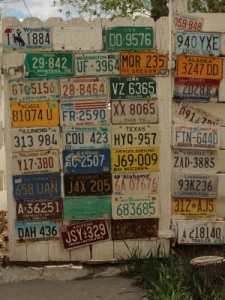
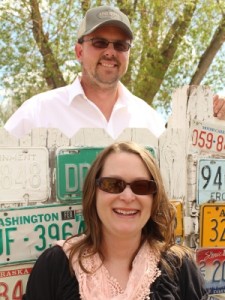 made me think with interest about the array of license plates my father-in-law had collected, and in reality about the kind of man he was.
made me think with interest about the array of license plates my father-in-law had collected, and in reality about the kind of man he was.
The things that were cherished to him were really the life moments. Things like his knife and watch, his tools, his woodworking supplies and chair making supplies, and yes, the license place collection, were things that had a special meaning to him. They were like the stories of his life. They were the accomplishments he had made, the places he had been, and the reminders of just how precious life was. While the license plates were not something I was interested in receiving, I am very glad that I have pictures of them to remember his passion for life.
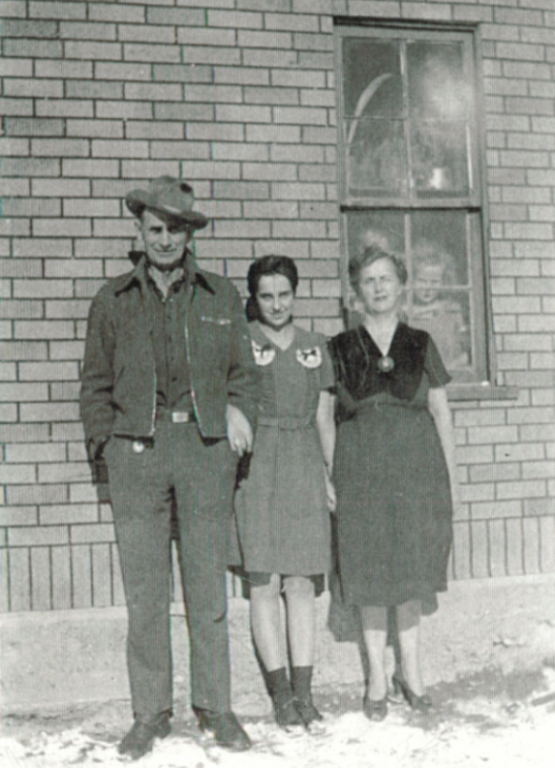 When most people think of the barracks, they think of a military facility, but not so my mother’s family. For all of their childhood, the barracks meant the bedroom. No, it isn’t because that is what they called the bedroom, because, they didn’t call the bedroom that. While visiting with my aunts, Sandy Pattan and Bonnie McDaniels, and cousins Susie Young, Shannon Limmer, and Jamie Patsie, after my mother passed away a week ago, we got on the subject of precious memories…which naturally took us to my grandpa and grandma, George and Hattie Byer’s house in North Casper, where they lived for many years right next door to his mother, my great grandma, Edna Byer. The two houses were very similar, but my grandparents house had an extra, very long bedroom attached to the back of the house. Grandma and Grandpa’s room was in from of that back bedroom, and there was another room where the two boys slept, but the girls all shared that huge back bedroom.
When most people think of the barracks, they think of a military facility, but not so my mother’s family. For all of their childhood, the barracks meant the bedroom. No, it isn’t because that is what they called the bedroom, because, they didn’t call the bedroom that. While visiting with my aunts, Sandy Pattan and Bonnie McDaniels, and cousins Susie Young, Shannon Limmer, and Jamie Patsie, after my mother passed away a week ago, we got on the subject of precious memories…which naturally took us to my grandpa and grandma, George and Hattie Byer’s house in North Casper, where they lived for many years right next door to his mother, my great grandma, Edna Byer. The two houses were very similar, but my grandparents house had an extra, very long bedroom attached to the back of the house. Grandma and Grandpa’s room was in from of that back bedroom, and there was another room where the two boys slept, but the girls all shared that huge back bedroom.
We always loved to go play back there, because it was a long room with lots of beds, and it just seemed very interesting to all the grandkids. I suppose that to the aunts and uncles, it was just normal, be we had really never seen anything like it. We began to talk about what spending the night in that back bedroom was like. There was no heat in that back room, so at night grandpa would heat rocks in the cook stove, and wrap them in a towel. Once the girls were tucked into bed, under a mountain of blankets, grandpa would come in and stick those towel wrapped rocks under the blankets at their feet. What a wonderful thing those rocks were. Aunt Bonnie tells me that they would immediately put their feet on those rocks, and before long, they would be all warm and cozy for the night. In the absence of heat, the blankets and the rocks did the job of keeping them warm quite well.
For us grandkids, the best way to play in that room in the winter cold, was to keep moving. I don’t think my aunts spent much time in there other than sleeping, because it was just too cold in winter. The main living room and kitchen were heated by the cook stove, and I’m here to tell you that those rooms were very warm…a fact that was just fine with me, since I have a tendency to get cold. Nevertheless, after some time in the main part of the house, the cooler bedroom could come as a nice change, until you got cold, then you went back out to the main rooms to warm up.
I had always wondered about the house with the long bedroom, and how it came to be…but no longer. As we were talking about those old days, my Aunt Sandy cleared that question right up. It turns out that both houses, Great Grandma’s and my grandparents, were originally old barracks from the air force base that used to be 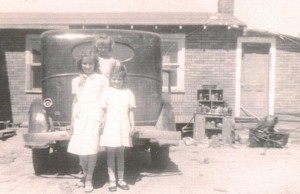 located in Casper. I don’t know for sure when they became the two houses, but that is what happened. My grandparents’ house had the added barracks to it, making up the big back bedroom where so many childhood memories for my mom, aunts, uncles, and many of the grandchildren, were built. In those days, times were tough, and people had to make do with what they had. In my opinion, the barracks and the houses attached to them, were more than just a way to make do. They are the houses I remember fondly from my own childhood years. We used to love going to visit Grandma and Grandpa. The house was always cozy, and my grandparents always pleased to see us. I get a warm cozy feeling just thinking about those visits.
located in Casper. I don’t know for sure when they became the two houses, but that is what happened. My grandparents’ house had the added barracks to it, making up the big back bedroom where so many childhood memories for my mom, aunts, uncles, and many of the grandchildren, were built. In those days, times were tough, and people had to make do with what they had. In my opinion, the barracks and the houses attached to them, were more than just a way to make do. They are the houses I remember fondly from my own childhood years. We used to love going to visit Grandma and Grandpa. The house was always cozy, and my grandparents always pleased to see us. I get a warm cozy feeling just thinking about those visits.
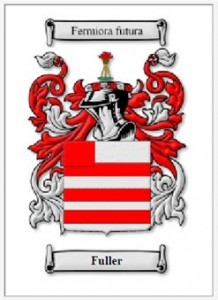 For many people researching the family history means looking for things like famous ancestors, family occupations, historical locations, and eventually the family crest, also known as the Coat of Arms. The problem with the family crest is that there are so many, and the process to make a legal claim to one is difficult, because the right to bear arms in the legal sense of a coat of arms, must be researched and proven through attested Genealogical records. Of course, this doesn’t mean that people can’t pick out a crest that bears their name and use it, even without the legal documentation. They can be displayed as decorative reproductions, derived only from the association with your name. That use, while legal in the sense that you are not committing a crime, is not the legal right to bear arms that is normally associated with the crest.
For many people researching the family history means looking for things like famous ancestors, family occupations, historical locations, and eventually the family crest, also known as the Coat of Arms. The problem with the family crest is that there are so many, and the process to make a legal claim to one is difficult, because the right to bear arms in the legal sense of a coat of arms, must be researched and proven through attested Genealogical records. Of course, this doesn’t mean that people can’t pick out a crest that bears their name and use it, even without the legal documentation. They can be displayed as decorative reproductions, derived only from the association with your name. That use, while legal in the sense that you are not committing a crime, is not the legal right to bear arms that is normally associated with the crest.
Sometimes, for those who are very fortunate, the family coat of arms might be found in a grandparent’s attic, but most of us will not discover our true coat of arms in this manner. Because of the difficulty in locating the necessary information to claim a legal right to a family coat of arms, most people just don’t bother with this part of a full family history. According to LG Pine, author of Heraldry And Genealogy, “At the onset, there is a curious fact in the relationship between the two subjects. While students of Heraldry do take to Genealogy, and acquire a considerable knowledge of it, those who begin as genealogists seldom if ever take any interest in Heraldry. This is most unfortunate, because the two subjects are necessarily related.” I suppose this is true, but once you have stumbled upon a family coat of arms in your research, like I did a few years ago, you simply do become intrigued.
Nevertheless, I had no idea about the legal right to bear arms until I was doing some research into the coat of arms of the Leary side of Bob’s family the other day. I had found several family coats of arms for the Spencer, Byer, Pattan, Fuller, and Schulenberg sides of the family, and planned to look for some of the others in the near future. While I will still do that, I have to wonder about the accuracy of the ones I have, and just how  difficult it will be to verify their validity. I can see that I will need to do some research on just how to move forward on this matter in the correct way.
difficult it will be to verify their validity. I can see that I will need to do some research on just how to move forward on this matter in the correct way.
The biggest obstacle I see in researching Heraldry or Genealogy is that the spelling of names changes. Whether it is because the person moved to a new nation and was made to change their name or spelling, or like many people do with their first names these days, the person experimented with the spelling of their last name. William Shakespeare was known to spell his last name Shakespeare, Shakespere, Shakespear, Shakspere, and Shaxpere. So to the researcher, I suppose it would be a matter of searching for documentation under multiple different spellings. You can see that the further you get into a search, the more difficult it is to determine the accuracy. So now apply that to the search concerning the legal right to bear arms, and I think you might have the answer as to why so many people avoid this area of research altogether.
 The dukedom of Marlborough is one of the titles in the Peerage of England. The Peerage of England comprises all peerages created in the Kingdom of England before the Act of Union in 1707. In that year, the Peerages of England and Scotland were replaced by one Peerage of Great Britain. The peerage is a legal system of largely hereditary titles in the United Kingdom, which is constituted by the ranks of British nobility and is part of the British honors system. The dukedom of Marlborough was created by Queen Anne in 1702, for John Churchill, who was the 1st Duke of Marlborough.
The dukedom of Marlborough is one of the titles in the Peerage of England. The Peerage of England comprises all peerages created in the Kingdom of England before the Act of Union in 1707. In that year, the Peerages of England and Scotland were replaced by one Peerage of Great Britain. The peerage is a legal system of largely hereditary titles in the United Kingdom, which is constituted by the ranks of British nobility and is part of the British honors system. The dukedom of Marlborough was created by Queen Anne in 1702, for John Churchill, who was the 1st Duke of Marlborough.
I can’t say that I completely understand all there is to about the peerage of Great Britain, but in the peerage, a Duke is a higher rank than a Marquess, Earl, Viscount and Baron. Thus Prince William is the Duke of Cambridge, because as the prince, it would not be right for him to have a lower rank than other members of the peerage. Originally dukes were the rulers of the provinces of the Roman Empire. Now however, the title of duke has become in almost all cases a nominal rank, without possession of an actual principality. The province that a duke was titled over, is known as a duchy. As I said, in modern times dukes aren’t really over a duchy, with the exception of Lancaster and Cornwall, both of which do include land and ownership. Lancaster belongs to Queen Elizabeth II and Cornwall to Prince Charles. The title of duke cannot normally be handed down to female heirs, but the Dukedom of Marlborough is the exception to that rule. It is one of the few titles that allows females to inherit the title, and the only current dukedom to do so.
In the Spencer family, there have been a number of titles, but it wasn’t until Charles Spencer, 3rd Earl of Sunderland, widowed following the death of his first wife, Arabella, daughter of Henry Cavendish, 2nd Duke of  Newcastle, married Anne Churchill, that the Dukedom of Marlborough first came to the Spencers. With this dukedom, Charles Spencer was first introduced to politics, making this alliance between Sunderland and Marlborough a very important one for Charles and his descendants. From his marriage to Anne Churchill who would become the 2nd Duke of Marlborough, the Spencer family would retain the dukedom for all time. At the current time, the dukedom is at 12, with Charles James Spencer-Churchill, 12th Duke of Marlborough, born in 1955, as the current duke.
Newcastle, married Anne Churchill, that the Dukedom of Marlborough first came to the Spencers. With this dukedom, Charles Spencer was first introduced to politics, making this alliance between Sunderland and Marlborough a very important one for Charles and his descendants. From his marriage to Anne Churchill who would become the 2nd Duke of Marlborough, the Spencer family would retain the dukedom for all time. At the current time, the dukedom is at 12, with Charles James Spencer-Churchill, 12th Duke of Marlborough, born in 1955, as the current duke.
To date, I cannot say how many dukes and duchesses were or are Spencer descendants, for names change with marriages over the years. Nevertheless, the Spencers have played a great part in the peerage of Great Britain, and with Prince William and his descendants, beginning with Prince George, the Spencers will continue to have great influence in that nation for the rest of time.
 Traditionally, we think of Valentine’s Day as a day of romance and love, but is that really what it is all about? There are several versions of the background surrounding Valentine’s Day, and all of them include St Valentine. The one I find most intriguing involved not love and romance exactly, but rather a time when it was not allowed. St Valentine was a priest who lived around 270 AD in Rome. He found himself at odds with the Roman emperor of the time, Claudius II.
Traditionally, we think of Valentine’s Day as a day of romance and love, but is that really what it is all about? There are several versions of the background surrounding Valentine’s Day, and all of them include St Valentine. The one I find most intriguing involved not love and romance exactly, but rather a time when it was not allowed. St Valentine was a priest who lived around 270 AD in Rome. He found himself at odds with the Roman emperor of the time, Claudius II.
During Saint Valentine’s life time, and under the ruling of Claudius II and other insane administrators, the quality of life in Rome, what had previously been known as the Golden Era, came to an end. There was strife, education declined, taxation increased, and trade declined. This caused a need for more and more soldiers and officers to protect the nation from takeover by the Gauls, Slavs, Huns, Turks and Mongolians from Northern Europe and Asia. In his insanity, Claudius II felt that married men were more emotionally attached to their families, and thus, will not make good soldiers, and he needed many soldiers now. He believed that marriage made the men weak. So he issued an decree forbidding marriage to assure quality soldiers
The people of Rome were afraid of the emperor, and when he made the decision to ban marriage, the people 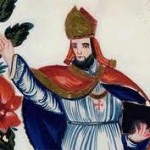 dared not protest, even though they were shocked. If Claudius II had given any thought to the consequences of his ban, he might have realized how futile it was. If the people did not marry, or at least reproduce, his army would dwindle down to nothing in a matter of years, and if they did at least reproduce, weren’t they still having the same emotional ties as married people? This just goes to show how insane Claudius II was.
dared not protest, even though they were shocked. If Claudius II had given any thought to the consequences of his ban, he might have realized how futile it was. If the people did not marry, or at least reproduce, his army would dwindle down to nothing in a matter of years, and if they did at least reproduce, weren’t they still having the same emotional ties as married people? This just goes to show how insane Claudius II was.
Saint Valentine was a bishop at this time in history, and so began holding secret marriage ceremonies for the soldiers, in complete opposition to Claudius II’s ruling. Saint Valentine was a kindly bishop, and he saw the trauma the unjust decree was causing to young lovers, who had given up all hope of marrying and having children. So, he began secretly performing these marriage ceremonies on the soldiers and their young ladies. Unfortunately, these marriages could not remain hidden for long, and when Claudius II found out about this “friend of lovers”, he was furious. Saint Valentine was arrested and put in prison. Claudius II was impressed with Saint Valentine, when he met him, but when he would not convert to the Roman gods and agree to abide by the marriage ban, Claudius II was angered, and sentenced him to death.
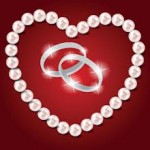 While awaiting his death sentence, Saint Valentine was approached by his jailor, Asterius whose daughter was blind. Asterius had heard that Saint Valentine was a healer. He asked him to heal his daughter, who was blind. Saint Valentine prayed and the jailor’s daughter was healed. After she was healed, a deep friendship developed between Saint Valentine and the jailor’s daughter, and she was grieved over his imminent death. Right before he was beheaded, Saint Valentine wrote her a farewell message, and signed it “From your Valentine”. It is this note that is said to have begun the traditional Valentine card. Saint Valentine is believe to have been executed on February 14, 270 AD, hence the date for our romantic holiday. In reality it is a day to celebrate the Friend of Lovers. Happy Valentines Day!!
While awaiting his death sentence, Saint Valentine was approached by his jailor, Asterius whose daughter was blind. Asterius had heard that Saint Valentine was a healer. He asked him to heal his daughter, who was blind. Saint Valentine prayed and the jailor’s daughter was healed. After she was healed, a deep friendship developed between Saint Valentine and the jailor’s daughter, and she was grieved over his imminent death. Right before he was beheaded, Saint Valentine wrote her a farewell message, and signed it “From your Valentine”. It is this note that is said to have begun the traditional Valentine card. Saint Valentine is believe to have been executed on February 14, 270 AD, hence the date for our romantic holiday. In reality it is a day to celebrate the Friend of Lovers. Happy Valentines Day!!
 Since my oldest grandson, Chris Petersen turned eighteen last February 28th, and had to register for the draft, and my grandson, Caalab Royce will be registering in June after he turns eighteen this year on the 25th, I have wondered a little more about the making of a soldier…in any war. Since the draft is something that almost never happens these days, it was not a real priority in my mind, however. Then I started looking at my Aunt Bertha Hallgren’s journal again, because she was such a great writer, and because I haven’t referred to her work in a while. I stumbled across a reference she makes to the experience of a World War I soldier. Since my grandfather, George Byer fought in World War I, that part of her journal made me curious.
Since my oldest grandson, Chris Petersen turned eighteen last February 28th, and had to register for the draft, and my grandson, Caalab Royce will be registering in June after he turns eighteen this year on the 25th, I have wondered a little more about the making of a soldier…in any war. Since the draft is something that almost never happens these days, it was not a real priority in my mind, however. Then I started looking at my Aunt Bertha Hallgren’s journal again, because she was such a great writer, and because I haven’t referred to her work in a while. I stumbled across a reference she makes to the experience of a World War I soldier. Since my grandfather, George Byer fought in World War I, that part of her journal made me curious.
The story Aunt Bertha wrote was funny to a large degree, although I doubt that the soldier she wrote abut thought it was funny exactly. I suppose that as a eighteen year old boy, at a time when education was not always the top priority, he did not always understand the new to him words that were being thrown at him, being asked if you were an alien, might make you wonder if they were asking if you were sick right now, but the humor was somehow lost on the officer who was asking the questions. And when he asks you your name, and he has known you all your life, because he’s your milkman, it might be hard not to say, “You know my name.” Nevertheless, you must quickly learn that knowing you in life and knowing you in the military are obviously two very different things. You had better just answer the question and not act like a smart-aleck.
After getting past the registration area, and getting the feeling that these guys didn’t expect you to make it past the first week in combat, you might start looking for the door, and wondering if there was any way to make them believe you were only seventeen after all. Nevertheless, the line moved forward, and there was no way to get out of it, so you followed along. At some point you were issued a uniform, which the soldier Bertha was talking about described as one of two sizes…too small or too big. He pointed out that the pants were so tight that he didn’t dare sit down, and the shoes were so big that he could “turn around twice, and they didn’t move”. Sadly, I think that is the way it was during World War I. A guy could probably deal with the loose fitting clothes, but those tight ones wouldn’t last long. And to make matters worse for our particular soldier, he passed an officer, who immediately asked him if he had noticed the uniform the officer was wearing. In his typical eighteen year old mouthiness, and his lack of understanding the meaning of the question, our new soldier, asked why the officer was complaining. Hadn’t he seen how ill fitting the soldiers uniform was after all. I seriously doubt if the officer saw the humor in that.
After another mouthy session, the soldier found himself digging a hole…then being told to dig another one to throw the dirt into. I guess you can see where this task was heading. If our soldier didn’t figure out pretty fast  that he needed to keep his sarcasm to himself, then it is my guess that he spent a lot of time peeling potatoes, scrubbing floors, and digging holes…when he wasn’t fighting for his life that is. As time went on, I’m sure he figured out that they didn’t care about his opinion, and if he gave it anyway, he was going to wish he hadn’t. While this type of soldier would not really make a great soldier, he would probably have made a funny movie. I’m sure he got over the need to be funny once the bullets started flying too. By the way, I really don’t recommend that any of the soldiers, who might be coming up the ranks, act this way. I think that while sarcasm in school might make you the class clown, and make you popular with your friends, because that’s what kids do, it will not have the same affect on your commanding officer in any way, shape, or form.
that he needed to keep his sarcasm to himself, then it is my guess that he spent a lot of time peeling potatoes, scrubbing floors, and digging holes…when he wasn’t fighting for his life that is. As time went on, I’m sure he figured out that they didn’t care about his opinion, and if he gave it anyway, he was going to wish he hadn’t. While this type of soldier would not really make a great soldier, he would probably have made a funny movie. I’m sure he got over the need to be funny once the bullets started flying too. By the way, I really don’t recommend that any of the soldiers, who might be coming up the ranks, act this way. I think that while sarcasm in school might make you the class clown, and make you popular with your friends, because that’s what kids do, it will not have the same affect on your commanding officer in any way, shape, or form.
 Probably my favorite historical President, would have to be Abraham Lincoln. Even in elementary school, I found his political acts to be most interesting. Of course, my favorite speech would have to be the Gettysburg Address. Every time I hear that speech, I get Goosebumps. I’m sure I’m not alone in that either. That was such a moving speech. It was at a time when our nation was severely divided, and on the brink of splitting in two. No one could agree on what we should be like. And yet, I believe that Lincoln made the right call. Owning slaves was wrong, and if it took a war to free them, then that was the way it would have to be. I am also glad that our nation did not divide, as I think we are a great nation because of our strongly united stance.
Probably my favorite historical President, would have to be Abraham Lincoln. Even in elementary school, I found his political acts to be most interesting. Of course, my favorite speech would have to be the Gettysburg Address. Every time I hear that speech, I get Goosebumps. I’m sure I’m not alone in that either. That was such a moving speech. It was at a time when our nation was severely divided, and on the brink of splitting in two. No one could agree on what we should be like. And yet, I believe that Lincoln made the right call. Owning slaves was wrong, and if it took a war to free them, then that was the way it would have to be. I am also glad that our nation did not divide, as I think we are a great nation because of our strongly united stance.
Apparently, our nation agrees with me on just how great Abraham Lincoln was too, because on this day…his birthday…in 1914, the first stones were laid for the Lincoln Memorial. I doubt that the connection was lost to those who 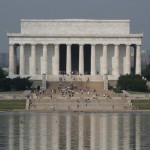 were doing the work on the splendid memorial, and maybe the work had officially been planned for that day for that very reason. Lincoln was known as the “Saviour of the Union” because of his actions to keep our nation together. The inscription reads, “In this temple, as in the hearts of the people for whom he saved the Union, the memory of Abraham Lincoln is enshrined forever.” And beneath these words, the 16th President of the United States sits immortalized in marble as an enduring symbol of unity, strength, and wisdom. I have to wonder if Lincoln would have been embarrassed or humbled by such a display. I’m sure he would be humbled, but I also think that because Lincoln was such a humble man, he would have also been a bit embarrassed.
were doing the work on the splendid memorial, and maybe the work had officially been planned for that day for that very reason. Lincoln was known as the “Saviour of the Union” because of his actions to keep our nation together. The inscription reads, “In this temple, as in the hearts of the people for whom he saved the Union, the memory of Abraham Lincoln is enshrined forever.” And beneath these words, the 16th President of the United States sits immortalized in marble as an enduring symbol of unity, strength, and wisdom. I have to wonder if Lincoln would have been embarrassed or humbled by such a display. I’m sure he would be humbled, but I also think that because Lincoln was such a humble man, he would have also been a bit embarrassed.
Abraham Lincoln came from humble beginnings. He was raised in what was then the western frontier in Kentucky and Indiana. He was mostly self educated, and became a lawyer in Illinois. He was a member of the 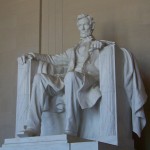 Whig Party, which is now gone, and then became a member of the Republican Party in 1854. He hated slavery and spoke out against it many times. He didn’t have much support in the South, of course, but he swept the Northern states and became president in 1860. He also reached out to the War Democrats, those who supported the war. He also confronted the Republicans who wanted to punish the South after the war, and called for more compromise with the anti-war Democrats who hated him…trying to bring peace within the government even before the war ended. Nevertheless, just six days after Robert E Lee surrendered, President Abraham Lincoln was assassinated by John Wilkes Booth, who was a Confederate sympathizer. Today, we remember Abraham Lincoln on the 206th anniversary of his birth.
Whig Party, which is now gone, and then became a member of the Republican Party in 1854. He hated slavery and spoke out against it many times. He didn’t have much support in the South, of course, but he swept the Northern states and became president in 1860. He also reached out to the War Democrats, those who supported the war. He also confronted the Republicans who wanted to punish the South after the war, and called for more compromise with the anti-war Democrats who hated him…trying to bring peace within the government even before the war ended. Nevertheless, just six days after Robert E Lee surrendered, President Abraham Lincoln was assassinated by John Wilkes Booth, who was a Confederate sympathizer. Today, we remember Abraham Lincoln on the 206th anniversary of his birth.
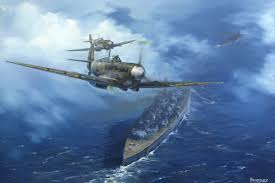 In any war, each side has just one goal in mind…winning. Of course, this is not just a video game or war games, but it is really a life and death challenge. In retrospect, I find it interesting to see some of the strategies the different sides use. While I cannot agree with anything the Germans did under Hitler’s rule, because Hitler was unbelievably ruthless, hateful, and cruel, there were some strategies that either he, his admirals, or his soldiers executed that were quite spectacular, though surprising in nature, because the Germans didn’t usually coordinate their efforts this well. I would never have wanted the Germans to win in World War II, because of their horrible treatment and murders of the Jewish people, but they did have a way of fighting that has captured my interest…at least on this day.
In any war, each side has just one goal in mind…winning. Of course, this is not just a video game or war games, but it is really a life and death challenge. In retrospect, I find it interesting to see some of the strategies the different sides use. While I cannot agree with anything the Germans did under Hitler’s rule, because Hitler was unbelievably ruthless, hateful, and cruel, there were some strategies that either he, his admirals, or his soldiers executed that were quite spectacular, though surprising in nature, because the Germans didn’t usually coordinate their efforts this well. I would never have wanted the Germans to win in World War II, because of their horrible treatment and murders of the Jewish people, but they did have a way of fighting that has captured my interest…at least on this day.
The Germans had controlled and occupied France since June of 1940. Their ships docked in French ports were drawing fire from the British. It became clear that the ships needed to escape. The German battleships Gneisenau and Scharnhorst had been anchored at the port of Brest since March of 1941, and the heavy cruiser, Prinz Eugen had been there since May of 1941. They were periodically subjected to bombing raids and damage at the hands of the British. Now it was time to turn a bad situation into a successful failure, as it were. The Germans knew they were not going to hold onto France here, so now they needed to steal away in the night without getting caught.
It was decided that they would make a mad dash up the English Channel to the safety of German waters. The  key here was to make the Channel Dash right under the watchful eye of the British Royal Navy without their notice. It was quite risky. Despite the watchfulness of the British submarines and aircraft, the German Vice Admiral, Otto Ciliax launched Operation Cerberus to lead the ships out of the French port, and to the safety of the German ports.
key here was to make the Channel Dash right under the watchful eye of the British Royal Navy without their notice. It was quite risky. Despite the watchfulness of the British submarines and aircraft, the German Vice Admiral, Otto Ciliax launched Operation Cerberus to lead the ships out of the French port, and to the safety of the German ports.
On the evening of February 11, 1942, they set their plan in motion. Accompanied by six German destroyers and twenty one torpedo boats for protection, they moved north late that evening. When daylight hit, they were joined by German planes to provide air cover as well. The air cover was led by ace pilot, Adolf Galland. He was joined by 250 other fighters in a coordinated joint effort of the German Navy and the Luftwaffe…an unusually well coordinated joint effort. The British Royal Navy scrambled to coordinate its own attack, but the late start would prove to be the undoing of the attack, because they did not realize that the escape was in progress until the afternoon of February 12th. All three of the German warships made it to a German port on February 13th, although the Gneisenau and had incurred damaged by British mines along the route. In addition to the embarrassment of the well planned escape that was carried out by the Germans, the British lost 40 aircraft and six Navy Swordfish during their confrontation. The Germans, on the other had, only lost one torpedo boat and 17 aircraft.
Nevertheless, the British would exact a revenge of sorts, when British warships sunk the Scharnhorst in December of 1944, as it attempted to attack a Russian convoy. The Gneisenau was destroyed during a bombing raid, while it was still being repaired from the prior damage, and the Prinz Eugen survived the war, but  was taken over by the US Navy at the end of the war. It isn’t that I want to commend the Germans for their sneaky escape, because I don’t. They simply lived to fight…and ultimately lose, another day. It was, however, a good strategy, and I guess that even crazy dictators like Hitler, and the men he trained, could come up with an occasional good escape plan. Nevertheless, evil must not be allowed to continue, and the Germans had to be shut down, so the British, and all the other nations who stand for what is good, had to continue to fight, until Germany and its allies had no choice but to surrender. Still, February 11, 1942, the day of The Channel Dash would stand out as one of the best fights put up by the Germans, or at least, the best escape plan.
was taken over by the US Navy at the end of the war. It isn’t that I want to commend the Germans for their sneaky escape, because I don’t. They simply lived to fight…and ultimately lose, another day. It was, however, a good strategy, and I guess that even crazy dictators like Hitler, and the men he trained, could come up with an occasional good escape plan. Nevertheless, evil must not be allowed to continue, and the Germans had to be shut down, so the British, and all the other nations who stand for what is good, had to continue to fight, until Germany and its allies had no choice but to surrender. Still, February 11, 1942, the day of The Channel Dash would stand out as one of the best fights put up by the Germans, or at least, the best escape plan.

